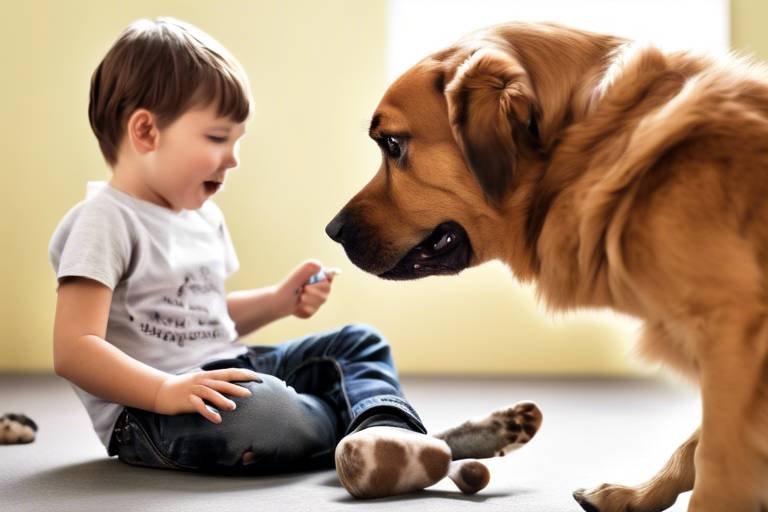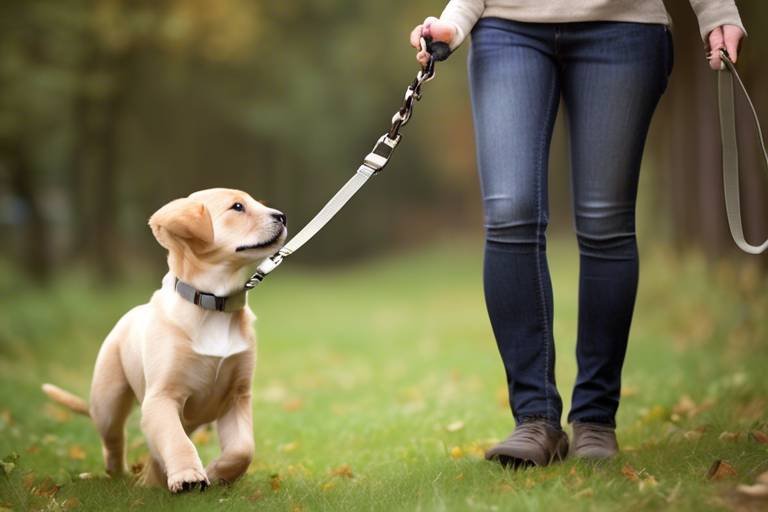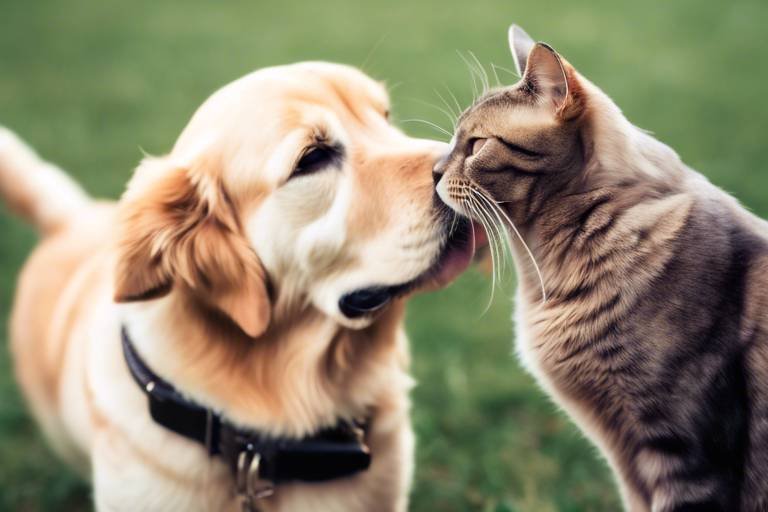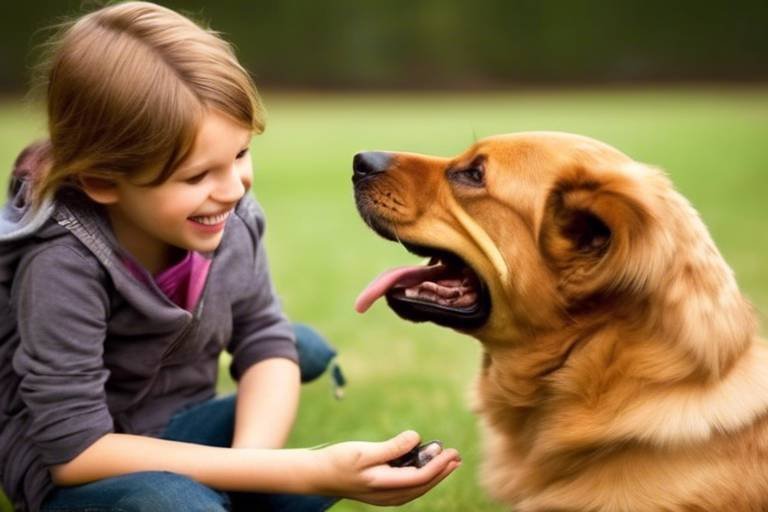The Importance of Patience in Pet Training
Training a pet is not just about teaching them commands—it's a journey that requires a great deal of patience. Imagine trying to teach a toddler how to tie their shoes; it takes time, repetition, and a lot of understanding. Similarly, pets, whether they are dogs, cats, or any other furry companion, need that same level of patience from their owners. When you embark on the training process, it’s crucial to remember that every pet learns at their own pace. This means that what works for one may not work for another, and that’s perfectly okay!
Patience plays a pivotal role in fostering a positive learning environment. When you approach training with a calm demeanor and an open heart, your pet is more likely to respond positively. Think of it this way: if you were trying to learn something new and your teacher was constantly frustrated, would you feel motivated to keep trying? Probably not. The same principle applies to our pets. They sense our emotions and can pick up on our frustrations, which can lead to anxiety and confusion. By cultivating patience, you create a safe space where your pet can thrive and learn.
Furthermore, patience allows for a deeper bond between you and your pet. As you navigate the ups and downs of training, you’ll find that the challenges you face can strengthen your relationship. Each small victory, whether it’s your dog finally sitting on command or your cat using the litter box consistently, is a moment to celebrate together. These shared experiences build trust, and trust is the foundation of any strong relationship.
In this article, we will explore various techniques and tips to enhance your training experience through patience. From understanding pet behavior to setting realistic goals, we’ll cover everything you need to know to make the training process enjoyable for both you and your furry friend. So, let’s dive in and discover how patience can transform your pet training journey!
Comprehending the natural instincts and behaviors of pets is essential for effective training. Each species, and indeed each individual pet, has its own unique set of behaviors that can influence how they learn. For example, dogs are pack animals and often thrive on social interaction, while cats may be more independent and require different motivational techniques. Understanding these nuances is key to tailoring your training approach.
Establishing achievable training objectives is vital for success. It's important to create realistic expectations that align with your pet's unique learning pace and abilities. For instance, if you have a puppy, expecting them to master complex tricks within a week may lead to frustration for both of you. Instead, aim for small, manageable goals that can be accomplished over time.
Differentiating between short-term and long-term goals helps in structuring training sessions effectively. Short-term goals might include teaching your pet to sit or stay, while long-term goals could involve more advanced training like agility or obedience competitions. Balancing both types of goals ensures that you maintain motivation and keep the training process exciting.
Tracking your pet's progress is crucial in maintaining motivation. Consider keeping a journal or using an app to note milestones and celebrate small victories throughout the training journey. This not only helps you stay organized but also provides a sense of accomplishment.
Flexibility in adjusting training goals is important. As your pet progresses, you may find that some objectives are too easy or too challenging. Don’t hesitate to modify them based on your pet’s performance and comfort level. This adaptability will keep the training process enjoyable and effective.
Training pets can present various challenges. From distractions in the environment to stubbornness in behavior, obstacles are bound to arise. However, with patience and persistence, these challenges can be overcome. Remember, every setback is an opportunity to learn and grow together.
Consistency in training reinforces learning. A steady routine helps your pet understand what is expected of them, making it easier for them to learn new commands. A lack of consistency can lead to confusion and frustration, both for you and your pet.
A well-structured training schedule can enhance learning. Consider setting aside specific times each day dedicated to training. This not only helps establish a routine but also signals to your pet that it’s time to focus and learn.
Using consistent commands is key to effective communication. Whether it’s verbal or non-verbal cues, uniformity helps your pet understand what you are asking of them. For example, if you use “sit” one day and “down” the next for the same command, your pet is bound to get confused.
- How long should training sessions be? Training sessions should ideally last between 5 to 15 minutes, depending on your pet's attention span.
- What if my pet isn’t responding to commands? It’s important to remain patient. Try different motivational techniques, such as treats or toys, to engage their interest.
- When should I start training my pet? Start training your pet as early as possible. Puppies and kittens are more receptive to learning new behaviors.
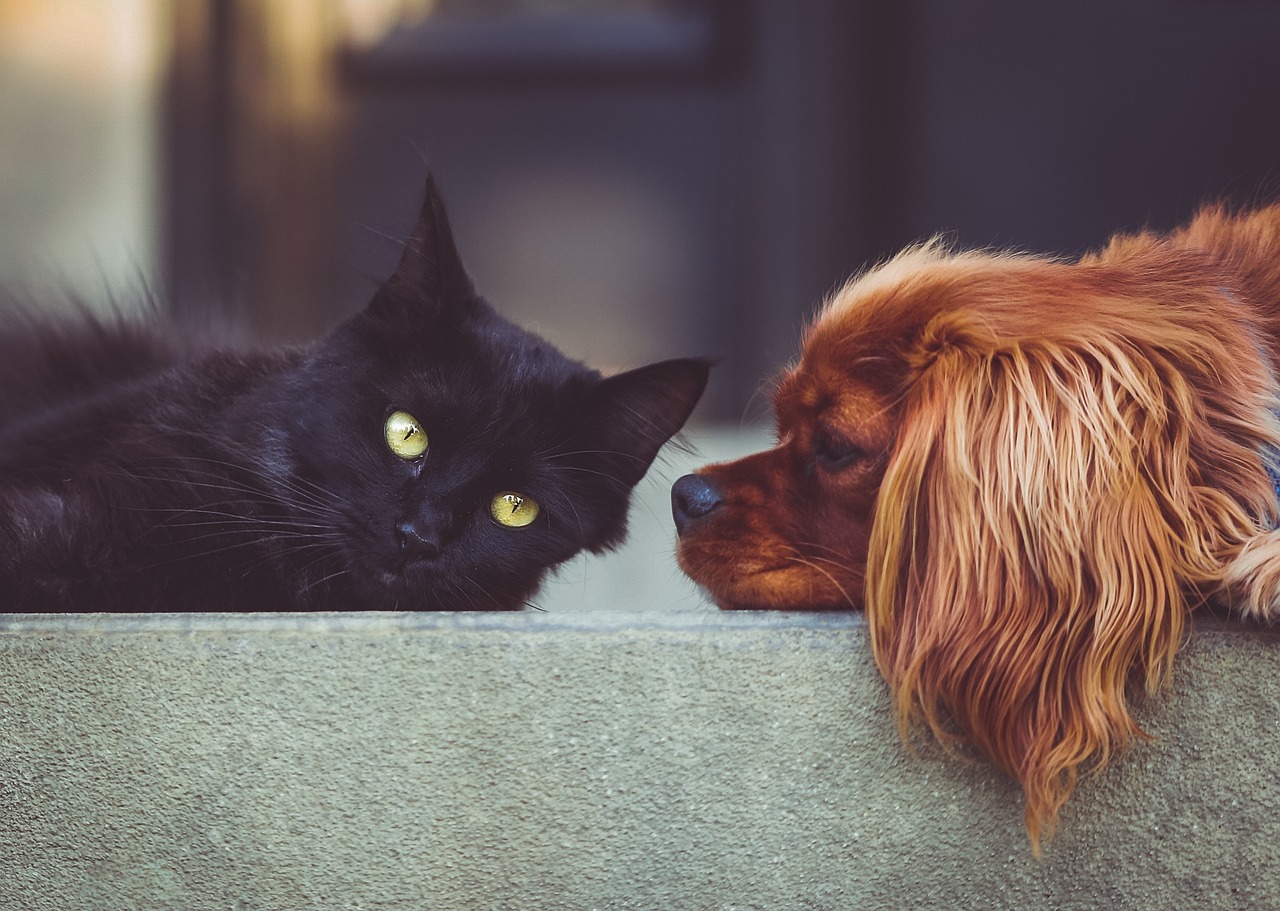
Understanding Pet Behavior
Comprehending the natural instincts and behaviors of pets is essential for effective training. Just like humans, pets have their own unique personalities and quirks that influence how they respond to training. For instance, a dog may be naturally more energetic and eager to please, while a cat might exhibit a more independent streak. Understanding these traits can help you tailor your training approach to meet your pet's specific needs.
One key aspect of pet behavior is the concept of body language. Pets communicate a lot through their physical actions. For example, a wagging tail in dogs often indicates excitement or happiness, while a cat that’s puffed up and hissing is clearly feeling threatened. Recognizing these signals can help you gauge your pet's mood and readiness to learn. It's like trying to decipher a secret code; once you crack it, everything becomes clearer!
Additionally, pets have certain instinctual behaviors that can affect their training. For example, dogs are pack animals and thrive on social interaction, which means they often respond well to group training sessions. Cats, on the other hand, are more solitary and may prefer one-on-one training. Understanding these instincts allows you to create a more effective training environment. Here are some common behavioral traits to keep in mind:
- Curiosity: Pets, especially young ones, are naturally curious and tend to explore their surroundings. Use this to your advantage by incorporating exploration into training.
- Attention Span: Pets have varying attention spans. Puppies may only focus for a few minutes, while older dogs might sustain attention longer. Tailor your training sessions accordingly.
- Reactivity: Some pets may react strongly to certain stimuli, such as loud noises or unfamiliar people. Recognizing these triggers is crucial to effective training.
Moreover, it's vital to remember that pets learn at their own pace. Patience is key! For example, if your dog isn’t picking up a command right away, it doesn’t mean they’re being stubborn; they might just need more time to understand what you’re asking. Think of it like teaching a child to ride a bike. Some kids take off in no time, while others need a bit more encouragement and practice. The same goes for your furry friends.
In conclusion, understanding your pet's behavior is like holding a map to their heart and mind. The more you know, the better you can communicate and train them. By paying attention to their instincts, body language, and unique traits, you’ll foster a positive training environment that encourages learning and strengthens your bond. Remember, patience and understanding are the cornerstones of successful pet training!
Q1: How can I tell if my pet is ready to learn?
A1: Look for signs of focus and interest. If your pet is calm and attentive, they are likely in a good mental space for training.
Q2: What should I do if my pet isn't responding to commands?
A2: Reassess your training approach. Try breaking down commands into smaller steps, and ensure you’re using positive reinforcement.
Q3: Is it normal for pets to have off days during training?
A3: Absolutely! Just like humans, pets can have good and bad days. If your pet seems distracted or unmotivated, it might be best to take a break and try again later.

Setting Realistic Training Goals
When it comes to pet training, one of the most critical aspects is setting realistic training goals. Think about it: if you expect your furry friend to master a new trick in a single session, you're likely setting yourself up for disappointment. Just like humans, pets have their own unique learning curves. They come with different backgrounds, experiences, and even temperaments, which can all influence their ability to learn. Therefore, it's essential to establish training objectives that are not only achievable but also tailored to your pet's specific needs.
So, how do you go about setting these goals? First, consider your pet's age, breed, and personality. For instance, a young puppy may have a shorter attention span compared to an older dog, who might be more focused and eager to please. Additionally, certain breeds are known for their intelligence and ability to learn quickly, while others may take a bit more time. By understanding these factors, you can create a training roadmap that aligns with your pet's capabilities.
Next, let's talk about the importance of short-term and long-term goals. Short-term goals are like stepping stones that lead to the bigger picture. For example, if your ultimate goal is to teach your dog to perform a complex trick, start with simpler commands like "sit" or "stay." Celebrate these small victories, as they build your pet's confidence and keep them motivated. On the other hand, long-term goals should be more comprehensive, focusing on the overall behavior you want to achieve. This could include everything from basic obedience to advanced tricks.
To help illustrate this concept, here's a simple table that outlines potential short-term and long-term goals:
| Short-Term Goals | Long-Term Goals |
|---|---|
| Teach "Sit" | Mastering "Stay" for extended periods |
| Introduce leash training | Walking politely without pulling |
| Learn "Come" on command | Reliable recall in various environments |
As you set these goals, remember that measuring progress is vital. Keeping track of your pet's achievements not only helps you stay organized but also allows you to adjust your training methods if necessary. You can use a simple journal or even an app to note down what works and what doesn’t. Celebrate those little wins! Maybe your dog learned to sit after just a few tries, or perhaps your cat finally uses the litter box consistently. Each of these milestones deserves recognition.
Lastly, it's crucial to remain flexible. Pets might surprise you with their learning abilities, or they might need more time than you anticipated. Being open to adjusting your training goals based on their performance is an essential part of the process. If you notice that your pet is struggling with a particular command, don’t hesitate to revisit the basics or slow down the pace of training. The key is to foster a positive learning environment where both you and your pet can thrive together.
Short-Term vs. Long-Term Goals
When it comes to pet training, understanding the difference between short-term and long-term goals is like having a roadmap for a successful journey. Short-term goals are those small, achievable milestones that you set for your pet, such as teaching them to sit or stay. These are the quick wins that not only boost your confidence as a trainer but also keep your furry friend engaged and motivated. Think of them as the stepping stones on the path to mastering more complex behaviors.
On the other hand, long-term goals are the bigger picture objectives, like having your dog reliably come when called or mastering a series of tricks. These goals require more time, patience, and consistent effort. They help to shape the overall behavior and relationship you want to cultivate with your pet. Imagine long-term goals as the foundation of a house; without them, your training efforts might feel scattered and unfocused.
To effectively balance short-term and long-term goals, consider the following strategies:
- Start Small: Begin with simple commands and gradually introduce more complex tasks as your pet gains confidence.
- Celebrate Small Wins: Each time your pet successfully learns a new command, reward them! This reinforces positive behavior and keeps the momentum going.
- Review and Adjust: Regularly assess both your short-term and long-term goals. If your pet is struggling with a particular command, it might be time to break it down into smaller, more manageable steps.
For example, if your long-term goal is to have your dog perform a series of tricks for a family gathering, your short-term goals could include teaching them to roll over and play dead. By focusing on these smaller tasks, you’re setting your pet up for success, which in turn nurtures their learning process.
Remember, the journey of training your pet is not a race. It’s essential to pace yourself and your pet. Balancing short-term and long-term goals not only makes the training process more enjoyable but also helps to build a stronger bond between you and your furry companion. So, take a deep breath, be patient, and enjoy the ride!
- How long should training sessions be? Training sessions should ideally last between 5 to 15 minutes, depending on your pet's attention span.
- What if my pet isn't responding to training? It might be helpful to reassess your training methods or take a break and try again later. Patience is key!
- Can I train my pet at home? Absolutely! Home training can be very effective, as long as you maintain consistency and a positive environment.
Measuring Progress
Measuring progress in pet training is not just about checking off a list of commands your furry friend has mastered; it's about celebrating the journey together. Every pet is unique, and their learning pace can vary significantly. To keep motivation high, it’s essential to have a clear understanding of what progress looks like for your pet. This means recognizing the small victories, such as when your pet responds to a command they previously ignored or when they show improved focus during training sessions.
One effective way to measure progress is to maintain a training journal. This can be a simple notebook or a digital document where you jot down observations after each training session. Note the commands practiced, your pet's responses, and any changes in behavior. Over time, this record will help you visualize improvements and identify patterns. For instance, if you notice your dog is consistently sitting on command after a week of practice, that’s a significant milestone worth celebrating!
Another method to gauge progress is through video recordings. Capturing your training sessions allows you to see how far your pet has come. You might be surprised to see improvements that aren’t immediately apparent during the sessions themselves. Watching these videos can also help you refine your techniques and adjust your training methods as needed. It’s like having a time machine that lets you go back and appreciate the growth!
In addition to personal observations, consider incorporating some measurable goals into your training. For example, you might set a target for your pet to master a new command within a specific timeframe. This could look something like this:
| Command | Start Date | Target Date | Status |
|---|---|---|---|
| Sit | March 1 | March 15 | In Progress |
| Stay | March 5 | March 20 | Not Started |
This table not only helps you stay organized but also provides a visual representation of your training journey. When your pet successfully learns a command, you can mark it as "Completed," giving both you and your pet a sense of achievement.
Lastly, remember that measuring progress is not just about the end goal; it's about enjoying the process. Celebrate those small wins with treats, praise, and playtime. After all, training should be a fun and rewarding experience for both you and your pet. So, keep your eyes peeled for those little moments of success, and don’t hesitate to reward your pet for their hard work. They’ll appreciate the encouragement, and it will strengthen your bond!
- How often should I measure my pet's progress? It's beneficial to measure progress after each training session and maintain a weekly overview to track trends.
- What should I do if my pet isn't progressing? If your pet is struggling, consider adjusting your training methods or goals. Sometimes, a different approach or more patience can make all the difference.
- Can I use treats to measure progress? Yes! Treats can be a great motivator. You can use them to reward your pet for achieving specific milestones.
Adjusting Goals as Needed
When it comes to pet training, one of the most vital aspects is the ability to adjust goals as needed. Just like humans, pets are unique individuals, each with their own pace of learning and comfort levels. As a pet owner, it’s essential to recognize that what works for one pet may not work for another. This means that flexibility is key. If you notice that your furry friend is struggling with a specific command or task, it’s perfectly okay to take a step back and re-evaluate your approach.
For instance, if your dog is having difficulty with the “sit” command, consider breaking it down into smaller steps. Start by rewarding them for simply looking at you when you say the word, then gradually move to rewarding them when they lower their bottom to the ground. This method not only makes the training process more manageable for your pet but also helps maintain their motivation and enthusiasm.
Additionally, it’s important to keep an eye on your pet’s emotional state during training sessions. If they seem overwhelmed or disinterested, it might be time to adjust your goals. Perhaps your training sessions are too long, or maybe the environment is too distracting. By paying attention to your pet’s behavior, you can make the necessary adjustments to create a more positive learning experience.
Here are a few tips on how to adjust your training goals effectively:
- Observe: Keep a close watch on your pet’s reactions. Are they engaged and eager, or are they showing signs of frustration?
- Communicate: Use consistent verbal and non-verbal cues, and be sure to reward them for any progress, no matter how small.
- Be Patient: Remember that learning takes time. If your pet isn’t catching on quickly, don’t rush the process.
- Modify Sessions: If a particular session isn’t going well, consider shortening it or changing the focus to a different command that your pet is more comfortable with.
Ultimately, the goal of pet training is to foster a trusting and loving relationship between you and your pet. By being willing to adjust your goals and methods, you not only help your pet learn more effectively but also create a more enjoyable training experience for both of you. Remember, patience is not just a virtue; it’s a necessity in the world of pet training!
Q: How often should I adjust my training goals?
A: It’s a good idea to reassess your training goals regularly, especially if you notice your pet struggling. Adjustments can be made after each training session or weekly, depending on your pet's progress.
Q: What are some signs that I need to adjust my training approach?
A: Signs include your pet showing signs of frustration, lack of interest, or not responding to commands. If training becomes a chore for either of you, it’s time to rethink your strategy.
Q: Can I adjust goals for different types of training?
A: Absolutely! Different types of training (like obedience, agility, or tricks) may require different adjustments. Tailor your goals to fit the specific training type and your pet's individual needs.
Common Training Challenges
Training your pet can sometimes feel like trying to teach a cat to fetch—frustrating and seemingly impossible! But fear not, every pet owner faces challenges along the way. Understanding these common hurdles is the first step in overcoming them. One of the most prevalent issues is inconsistent behavior. Pets, much like humans, can have off days. One moment they seem to grasp a command, and the next, they act as if they’ve never heard it before. This inconsistency can stem from a variety of factors, including distractions in the environment, lack of focus, or simply a pet's mood. Recognizing that your furry friend is not a robot can help you approach training with the patience it requires.
Another significant challenge is short attention spans. Just like a child who can't sit still in class, pets often struggle to maintain focus during training sessions. This can lead to frustration for both the owner and the pet. To combat this, try breaking training sessions into shorter, more engaging segments. For example, instead of a 30-minute session, aim for three 10-minute sessions throughout the day. This not only keeps your pet engaged but also allows for better retention of the commands being taught.
Additionally, there’s the issue of fear or anxiety. Some pets may be naturally timid or have had negative experiences that make them hesitant to engage in training. It’s essential to create a safe and positive environment for your pet. Use gentle tones, rewards, and lots of praise to build their confidence. In cases where anxiety is severe, consider consulting a professional trainer or behaviorist who can provide tailored strategies to help your pet feel more secure.
Lastly, let’s not forget the challenge of owner frustration. It’s easy to feel overwhelmed when progress seems slow or when your pet doesn’t respond as expected. Remember, training is a marathon, not a sprint! Celebrate small victories, and don’t hesitate to take breaks when needed. Your pet can sense your frustration, which might hinder their learning process. Maintain a calm demeanor and show them that learning can be fun!
In summary, while training your pet can be fraught with challenges, understanding these common obstacles can empower you to tackle them head-on. By embracing patience, creating a positive environment, and adjusting your approach as needed, you can navigate the ups and downs of pet training with confidence.
- What should I do if my pet isn't responding to commands?
Consider adjusting your training techniques, using more rewards, or breaking down commands into simpler steps. Patience is key!
- How long should training sessions last?
Shorter sessions of about 5-10 minutes are often more effective, especially for younger pets or those with shorter attention spans.
- Is it normal for my pet to have off days during training?
Absolutely! Just like us, pets can have varying energy levels and moods. It's important to be flexible and patient.

The Role of Consistency
When it comes to training your furry friend, consistency is not just a buzzword; it’s the backbone of effective learning. Imagine trying to learn a new language where the rules change every day—frustrating, right? Our pets feel the same way when training lacks consistency. Establishing a steady routine helps them understand what is expected of them. This means that every time you issue a command, it should be the same, whether you’re at home or out in the park. This uniformity creates a sense of security for your pet, allowing them to focus on learning rather than deciphering mixed signals.
For example, consider how you might teach your dog to sit. If one day you say “sit” and the next you say “down” for the same action, your dog will likely become confused. Instead, sticking to one command and using it consistently will help your pet grasp the behavior you want much faster. Moreover, consistency extends beyond just verbal commands; it includes your tone of voice, body language, and even the environment in which you train. If you always use a cheerful tone when rewarding good behavior, your pet will begin to associate that tone with positive outcomes.
Creating a training schedule is a fantastic way to maintain consistency. By setting aside specific times each day for training, you not only reinforce the learning process but also build a routine that your pet can rely on. Here’s a simple example of how a training week might look:
| Day | Training Focus | Duration |
|---|---|---|
| Monday | Basic Commands (Sit, Stay) | 15 minutes |
| Tuesday | Leash Training | 20 minutes |
| Wednesday | Recall Training | 15 minutes |
| Thursday | Socialization | 30 minutes |
| Friday | Trick Training (Shake, Roll Over) | 15 minutes |
| Saturday | Review Commands | 20 minutes |
| Sunday | Fun Day (Play and Practice) | Variable |
By sticking to a schedule like this, you not only reinforce what your pet has learned but also make training a fun and engaging activity. Remember, consistency is key, but it’s equally important to be patient. If your pet struggles with a command, don’t be discouraged. Adjust your approach but keep the command itself consistent.
In conclusion, the role of consistency in pet training cannot be overstated. It builds trust, reinforces learning, and creates a positive environment for both you and your pet. As you embark on this training journey, remember that every moment spent training your pet is a step toward a deeper bond and greater understanding between the two of you.
- How long should training sessions be? Training sessions should ideally last between 10 to 20 minutes to maintain your pet's focus and enthusiasm.
- What if my pet doesn't respond to commands? If your pet is not responding, try changing your approach or the environment. Sometimes distractions can hinder learning.
- Can I train my pet at home? Absolutely! Home is a great place for training, as it’s familiar and comfortable for your pet.
Creating a Training Schedule
Establishing a training schedule is like setting the stage for a thrilling performance; it lays down the groundwork for success in your pet's training journey. Just as actors rehearse their lines consistently to deliver a captivating show, your pet thrives on routine and predictability. A well-crafted training schedule not only helps you stay organized but also enhances your pet’s learning experience by creating a sense of security and expectation.
When creating a training schedule, consider the unique needs and personality of your pet. Some pets are more energetic in the morning, while others may be more receptive in the evening. Pay attention to their behavior and energy levels to determine the best times for training sessions. Aim for short, focused sessions—typically 5 to 15 minutes—especially for younger pets or those who may have shorter attention spans. This approach prevents frustration and keeps the training enjoyable.
It’s also essential to incorporate a variety of training exercises to keep things interesting. Here’s a sample weekly training schedule to give you an idea:
| Day | Training Focus | Duration |
|---|---|---|
| Monday | Basic Commands (Sit, Stay) | 10 minutes |
| Tuesday | Leash Training | 15 minutes |
| Wednesday | Socialization (Meeting New People) | 10 minutes |
| Thursday | Trick Training (Roll Over) | 10 minutes |
| Friday | Recall Training (Come) | 15 minutes |
| Saturday | Agility Exercises (Obstacle Course) | 20 minutes |
| Sunday | Review & Playtime | 30 minutes |
In this schedule, you can see how varied activities can keep your pet engaged while ensuring that you're covering essential training areas. Remember, flexibility is key! If your pet seems particularly distracted or tired on a certain day, don’t hesitate to adjust the schedule. The goal is to create a positive, stress-free environment where learning can flourish.
Finally, consistency is crucial. Try to stick to the same times each day for training sessions, as this helps your pet understand when they can expect to learn. Just like a child learns best in a structured environment, your furry friend will benefit from a predictable routine. Celebrate small milestones along the way, and don’t forget to reward your pet for their efforts! Positive reinforcement goes a long way in building their confidence and eagerness to learn.
- How long should each training session be? Aim for 5 to 15 minutes to maintain your pet's focus.
- What if my pet isn't responding? Adjust your approach, be patient, and consider their learning pace.
- Can I train my pet at different times each day? While flexibility is good, try to keep a consistent schedule for best results.
Maintaining Consistency in Commands
When it comes to pet training, consistency is king. Imagine trying to learn a new language, but every time someone speaks to you, they use different words for the same thing. Confusing, right? That's exactly how our pets feel when we change commands or gestures mid-training. By maintaining consistency in commands, we create a clear communication channel between us and our furry friends. This clarity not only helps them understand what we expect but also builds their confidence as they learn.
Using the same verbal commands and hand signals across all training sessions is crucial. For instance, if you decide to use the word "sit" for your dog, stick with it. Avoid mixing it up with phrases like "sit down" or "take a seat." This can lead to misunderstandings and frustration for both you and your pet. Consider creating a command chart to keep track of the words and signals you use. Here’s a simple example:
| Command | Action |
|---|---|
| Sit | Your pet sits down. |
| Stay | Your pet remains in place. |
| Come | Your pet returns to you. |
Additionally, it's essential to involve everyone in the household in the training process. If one family member uses "down" while another uses "lie down," your pet will likely get confused. To avoid this, hold a family meeting to discuss the commands you plan to use. This way, everyone is on the same page, and your pet will benefit from a unified approach.
Moreover, keep in mind that consistency isn't just about the words we say; it also extends to our tone of voice and body language. Dogs, for example, are incredibly perceptive to our emotions. If you say "stay" in a cheerful tone one day and in a frustrated tone the next, your dog may not respond the same way. Always aim for a calm and encouraging tone to reinforce positive behavior.
In summary, maintaining consistency in commands is a fundamental pillar of effective pet training. By using the same words, involving everyone in the household, and being mindful of our tone and body language, we can foster an environment where our pets feel secure and understood. Remember, patience and persistence will pay off in the long run, leading to a well-behaved and happy companion.
- Why is consistency important in pet training?
Consistency helps pets understand what is expected of them, reducing confusion and enhancing their ability to learn commands. - How can I ensure everyone in my household uses the same commands?
Hold a family meeting to discuss and agree on the commands and gestures to be used for training. - What should I do if my pet doesn’t respond to a command?
Be patient and consistent. Revisit the command and ensure you are using the same tone and body language each time.
Frequently Asked Questions
- Why is patience important in pet training?
Patience is crucial in pet training because it allows both the pet and the owner to learn at a comfortable pace. Just like humans, pets have unique learning styles and speeds. Rushing the process can lead to frustration and setbacks, making it harder for your furry friend to grasp new commands or behaviors. By being patient, you create a supportive environment where your pet can thrive.
- What are some common behavioral traits in pets?
Common behavioral traits in pets include curiosity, playfulness, and sometimes stubbornness. Understanding these traits is vital for effective training. For instance, a curious pet may get easily distracted, while a playful one might need extra motivation to focus. Recognizing these behaviors helps you tailor your training approach to better suit your pet's personality.
- How can I set realistic training goals?
Setting realistic training goals involves assessing your pet's current abilities and establishing achievable objectives. Start with small steps, like teaching basic commands such as "sit" or "stay," before moving on to more complex tasks. Remember, every pet learns at their own pace, so flexibility is key. Celebrate small victories to keep the motivation high!
- What are short-term vs. long-term training goals?
Short-term goals are immediate objectives you can achieve in a few training sessions, like getting your pet to respond to a command. Long-term goals are broader and may take weeks or months, such as mastering a trick or overcoming behavioral issues. Balancing both types of goals helps maintain focus and ensures steady progress in your training journey.
- How can I measure my pet's training progress?
Measuring your pet's progress can be done through various methods, such as keeping a training journal or using a chart to track milestones. Celebrate small achievements, like your pet successfully following a command for the first time. This not only boosts your pet's confidence but also keeps you motivated to continue the training process.
- What should I do if my pet isn't progressing?
If your pet isn't progressing as expected, it may be time to reassess your training methods. Consider adjusting your goals to better match your pet's learning style or pace. Sometimes, taking a step back and simplifying commands can help. Remember, patience is key—every pet learns differently, and it's important to adapt your approach as needed.
- How does consistency affect pet training?
Consistency is vital in pet training because it reinforces learning. Using the same commands and cues helps your pet understand what you expect from them. Establishing a routine also creates a sense of security for your pet, making them more receptive to learning. Remember, practice makes perfect, so keep your training sessions regular and structured!
- What should I include in a training schedule?
A good training schedule should include specific times for training sessions, the types of commands or tricks to focus on, and breaks to prevent your pet from becoming overwhelmed. Aim for short, frequent sessions rather than long marathons to keep your pet engaged. Flexibility is also essential; adjust your schedule based on your pet's mood and energy levels.
- Why are consistent commands important?
Using consistent commands is crucial because it helps your pet associate specific words or gestures with actions. If you change commands frequently, it can confuse your pet and slow down their learning. Stick to a set of clear, simple commands and use them consistently to enhance communication and understanding between you and your furry friend.


